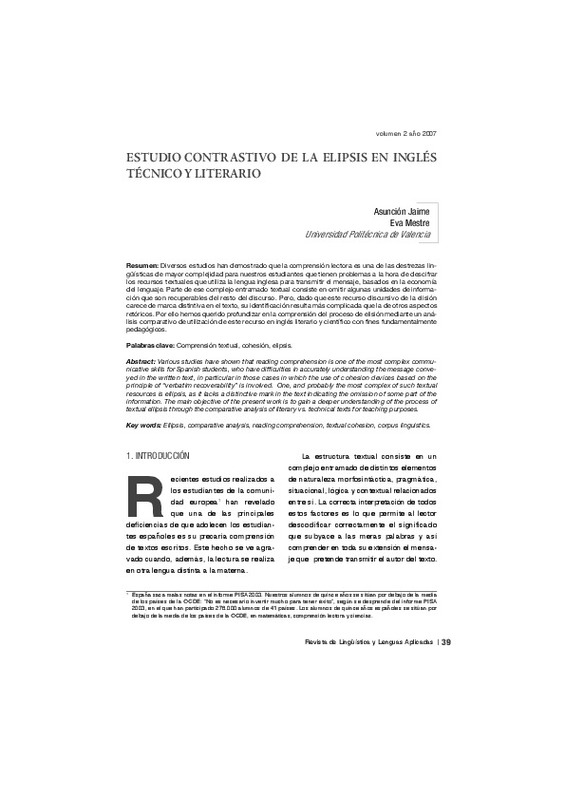JavaScript is disabled for your browser. Some features of this site may not work without it.
Buscar en RiuNet
Listar
Mi cuenta
Estadísticas
Ayuda RiuNet
Admin. UPV
ESTUDIO CONTRASTIVO DE LA ELIPSIS EN INGLÉS TÉCNICO Y LITERARIO
Mostrar el registro sencillo del ítem
Ficheros en el ítem
| dc.contributor.author | Jaime Pastor, Mª Asunción
|
|
| dc.contributor.author | Mestre i Mestre, Eva María
|
|
| dc.date.accessioned | 2011-03-31T13:14:50Z | |
| dc.date.available | 2011-03-31T13:14:50Z | |
| dc.date.issued | 2007 | |
| dc.identifier.issn | 1886-2438 | |
| dc.identifier.uri | http://hdl.handle.net/10251/10621 | |
| dc.description.abstract | [EN] Various studies have shown that reading comprehension is one of the most complex communicative skills for Spanish students, who have difficulties in accurately understanding the message conveyed in the written text, in particular in those cases in which the use of cohesion devices based on the principle of “verbatim recoverability” is involved. One, and probably the most complex of such textual resources is ellipsis, as it lacks a distinctive mark in the text indicating the omission of some part of the i n f o rmation. The main objective of the present work is to gain a deeper understanding of the process of textual ellipsis through the comparative analysis of literary vs. technical texts for teaching purposes. | es_ES |
| dc.description.abstract | [ES] Diversos estudios han demostrado que la comprensión lectora es una de las destrezas lingüísticas de mayor complejidad para nuestros estudiantes que tienen problemas a la hora de descifrar los recursos textuales que utiliza la lengua inglesa para transmitir el mensaje, basados en la economía del lenguaje. Parte de ese complejo entramado textual consiste en omitir algunas unidades de información que son recuperables del resto del discurso. Pero, dado que este recurso discursivo de la elisión carece de marca distintiva en el texto, su identificación resulta más complicada que la de otros aspectos retóricos. Por ello hemos querido profundizar en la comprensión del proceso de elisión mediante un aná- lisis comparativo de utilización de este recurso en inglés literario y científico con fines fundamentalmente pedagógicos. | |
| dc.language | Español | es_ES |
| dc.publisher | Editorial Universitat Politècnica de València | es_ES |
| dc.relation.ispartof | Revista de Lingüística y Lenguas Aplicadas | |
| dc.rights | Reserva de todos los derechos | es_ES |
| dc.subject | Comprensión textual | es_ES |
| dc.subject | Cohesión | es_ES |
| dc.subject | Elipsis | es_ES |
| dc.title | ESTUDIO CONTRASTIVO DE LA ELIPSIS EN INGLÉS TÉCNICO Y LITERARIO | es_ES |
| dc.type | Artículo | es_ES |
| dc.date.updated | 2011-03-31T12:32:46Z | |
| dc.identifier.doi | 10.4995/rlyla.2007.700 | |
| dc.rights.accessRights | Abierto | es_ES |
| dc.contributor.affiliation | Universitat Politècnica de València. Departamento de Lingüística Aplicada - Departament de Lingüística Aplicada | es_ES |
| dc.contributor.affiliation | Universitat Politècnica de València. Escuela Politécnica Superior de Gandia - Escola Politècnica Superior de Gandia | es_ES |
| dc.description.bibliographicCitation | Jaime Pastor, MA.; Mestre I Mestre, EM. (2007). ESTUDIO CONTRASTIVO DE LA ELIPSIS EN INGLÉS TÉCNICO Y LITERARIO. Revista de Lingüística y Lenguas Aplicadas. 2:39-46. https://doi.org/10.4995/rlyla.2007.700 | es_ES |
| dc.description.accrualMethod | SWORD | es_ES |
| dc.relation.publisherversion | https://doi.org/10.4995/rlyla.2007.700 | |
| dc.description.upvformatpinicio | 39 | |
| dc.description.upvformatpfin | 46 | |
| dc.description.volume | 2 | |
| dc.identifier.eissn | 1886-6298 | es_ES |
| dc.description.references | Fillmore, Ch. (1986). "Pragmatically controlled zero anaphora". Proceedings of the Berkeley Linguistics Society: 95-107. | es_ES |
| dc.description.references | Hahn, U. y M. Romacker. (1997). "Text Structures in Medical Text processing: empirical evidence and a text understanding prototype". Proceedings of AMIA Fall Symposium. | es_ES |
| dc.description.references | Hahn, U., M. Strube y K. Markert. (1996). "Bridging textual ellipses, International Conference On Computational Linguistics". Proceedings of the 16th conference on Computational linguistics, 1: 496 - 501. https://doi.org/10.3115/992628.992714 | es_ES |
| dc.description.references | Halliday, M. A. K. y R. Hasan. (1976). Cohesion in English. London: Longman. | es_ES |
| dc.description.references | Hankamer, J. e I. Sag. (1976). "Deep and surface anaphora." Linguistic Inquiry, 7(3): 128. | es_ES |
| dc.description.references | Informe PISA2003 OCDE PISA (2003). Data Analysis Manual. | es_ES |
| dc.description.references | James, C. (1980). Contrastive Analysis. London: Longman. | es_ES |
| dc.description.references | McEnery, Ty A. Wilson. (1996). Corpus Linguistics. Edinburgh: Edinburgh University Press | es_ES |
| dc.description.references | McEnery, Ty A. Wilson. (2001). Web supplement to Corpus Linguistics, (2nd ed): 3. | es_ES |
| dc.description.references | Postdam, E. (1997). "English Verbal Morphology and VP Ellipsis". Proceedings of the 27thMeeting of the NE Linguistic Society. Massachusetts: GLSA: 353-368. | es_ES |
| dc.description.references | Prague Dependency Treebank 2.0. (2006). http://ufal.mff.cuni.cz/pdt2.0/doc/manuals/en/a-layer/html/ch03s03.html. | es_ES |
| dc.description.references | Quirk, R. y S. Greenbaum. (1973).A Concise Grammar of Contemporary English. Harcourt Brace Jovanovich Inc. | es_ES |
| dc.description.references | Quirk, R., S. Greenbaum, S. Leech, y J. Svartvik. (1985). A Comprehensive Grammar of the English Language. London: Longman. | es_ES |
| dc.description.references | Rooth, M. (2006). "Ellipsis Redundancy and Reduction Redundancy". http://www.ims.uni-stuttgart.de/ftp/pub/papers/mats/ellipsis.ps.gz. | es_ES |
| dc.description.references | Te Velde, R. John.(2005)."Unifying prosody and syntax for right- and left-edge coordinate ellipsis". Lingua, 115: 483-502. https://doi.org/10.1016/j.lingua.2003.09.012 | es_ES |
| dc.description.references | Wijnen, C. (2005). "The interpretation of ellipsis: psycholinguistic studies". http://www.let.uu.nl/~Frank.Wijnen/personal/KNAW.html | es_ES |








